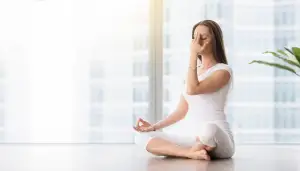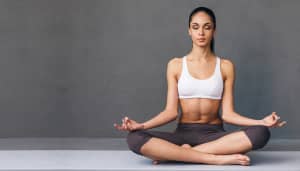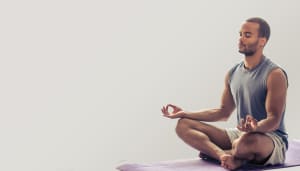Yoga- Pranayama
This Pranayama series contains breath practices which have the potential to effect the gross body.
What is Pranayam and its Benefits?
Pranayam yoga is a science of breathing or "control of breath". For those who have no idea of what is Pranayam and how it works. In short, it is a breathing exercise that deals with various types of breath control. It can also be called yoga for relaxation of the mind, body, and soul. In Sanskrit, the word "Prana" means "breath", and "yama" means "control". Pranayam yoga enhances the pranic energy, which is one of the main factors of life force and mental stability. Pranayam has numerous benefits that help the healthy functioning of the human body.
Yoga pranayam also balances and maintains the equation of the body, mind and soul, thus leading to a stress-free and relaxed state of mind. Once you set goals to regulate proper breathing, it helps you set things right internally. All your organs will begin to function actively and effectively once you practice pranayam yoga. One can also resolve minor respiratory issues and lung-related problems like asthma, wheezing, etc., by practicing Pranayam. Regular yoga and Pranayam can also help reduce hypertension, heart troubles, digestive disorders, anxiety, depression, etc. Pranayam yoga is an overall benefit to the entire functioning of the human body. The process of Pranayam is considered one of the most ancient disciplines in attaining peace of mind.
How Effectively Can We Do Pranayam at Home?
Performing pranayama at home does not require any special equipment and the only thing is that the spine has to be maintained tall. Hence it can be done effectively at home every day with ease. How to do pranayama at home? One has to take a steady breath through both the nostrils and such that the deep inhalation reaches the lungs to its maximum capacity. Then by holding the breath for a second and constricting some of it at the back of the throat, it should be exhaled gently like a whisper through both nostrils slowly. By doing this at home on a regular basis, you can reduce stress, relax the mind, and release anger.
Who Can Do Pranayam?
All age groups can do pranayam, just like yoga for senior citizens , yoga for relaxation, and yoga for sleep. It is a simple breathing technique that is incorporated in various yogas and even in surya namaskar. Kids can easily learn it as they are easy to understand and do not require more time to practice. Any kid above eight years is suitable to practice pranayam under all circumstances, and there is no max age limit to learn it.
Who Should Avoid Pranayam?
Pranayam is very beneficial for human health in various ways, but some populations of people should avoid it for their safety. They are:
· People with a heart failure
· People with breathing difficulties who cannot take up minimal exertion.
Benefits of Doing Pranayam Workouts
The benefits of pranayam, according to scientific studies, are extensively researched and provide good health in various ways.
· It decreases stress in all populations and ages as it calms the nervous system and improves the stress response.
· It decreases anxiety levels.
· It is the most effective pranayama that increases oxygen uptake by the vital organs and the brain and nerves.
· It improves sleep quality and is of great help to people with sleep apnea.
· It slows down the breathing and heart rate within a short duration of five minutes.
· It helps to calm the body tremendously.
· It decreases snoring, and daytime sleepy feels.
· It increases mindfulness as we tend to become aware of our breathing. Eventually, this helps to improve focus and concentration.
· It helps with the emotional regulation in the system.
· Pranayam removes the carbon dioxide and increases oxygen concentration in the body, which fuels the brain cells.
· It is the most effective pranayama that reduces high blood pressure and hypertension and promotes relaxation.
· It decreases the risk of both stroke and heart disease.
· It improves lung function as slow and forceful breathing strengthens the lungs.
· It helps to treat conditions like asthma, allergic bronchitis, pneumonia, and tuberculosis.
· It enhances cognitive performance and improves brain functionality.
· It improves the memory power and also reasoning skills of a person.
· It is seen to increase sensory-motor performance and also auditory memory.
· It helps to reduce cigarette cravings and quit the habit of smoking.
Disadvantages of Doing Pranayam Workouts
When pranayama is not done correctly, it may result in few side effects like:
· Dizziness
· Headache
· Vomiting sensation
· Lethargy
· Feeling giddy and having a weird sensation
· Lassitude
· Instable thoughts
· Discomfort and uneasiness
· Easily excitable mind
· Indigestion
· Constipation or diarrhea
· Depression
· Asthma worsens
· Dryness in mouth
· Restlessness
· Psychological imbalance
· Phobia or internal fear
· Excess salivation
· Perspiration
· Blood pressure and sugar level increases
· Immunity decreases
· Stress level increases
· Bach ache
· Blurry vision
· Body pain
Dos & Don’ts
The dos and don'ts associated with pranayam practice are:
· Do not practice yoga with any chronic medical condition and seek doctor's advice always.
· Pranayam steps must be practiced after an individual learns to control their body after learning all the asanas.
· Breathe only through the nose throughout the pranayam session.
· Please do not force the lungs beyond their limit, as any strain will traumatize the delicate respiratory organ.
· Continue to breathe steady and rhythmic and prevent producing sounds during the breathing process.
· One should not practice pranayam steps immediately after any meal.
· If the person has had food, they should wait for three hours to perform pranayama.
· Hold the breath only under the guidance of an expert, and beginners are requested not to hold their breath during the initial stages.
· If you are uncomfortable or tired, stop doing pranayama and shift to normal breathing.
· Relax for ten minutes in the middle of pranayama by doing pranayama.
· Do not perform any strenuous exercise after doing pranayam.
· One must never do pranayam in a hurry.
· It has to be practiced only in a well-ventilated room or outdoors.
· Do not perform it when the lungs are congested.
Things Required to Do Pranayam Workout if You Are at Home & Gym?
If you want to know how to do pranayam at home, the fundamental things one should need while performing pranyam are:
· Yoga mat
· Ventilated room
· Silent atmosphere
· Water
· Soothing music
· Towel
What are the Seven Pranayama?
There are different types of Pranayam for various purposes. Pranayam yoga is very effective when practiced under the guidance of yogic gurus or trained experts. However, there are a few pranayam steps that can be easily done at home. But make sure you learn advanced Pranayama from a properly trained yoga professional or guru. Basic Pranayam exercise or breathing exercise involves the below-
Natural Breathing – It is simply the awareness of breath. This process of Pranayam deals with a concentration on breathing in and breathing out of air. It helps us analyze and understand the breathing patterns of our bodies. This pranayam exercise can relax the mind immediately, no matter how much tension you have. It is also the basics of meditation. For beginners, it is essential to start from this stage. Sit in a comfortable position and place with no distractions if you are a beginner to yoga and Pranayam. It helps you concentrate more and divert less.
Basic Abdominal Breathing - If you are wondering how to do pranayam at home, then this abdominal breathing is the easiest. Abdominal breathing is inhaling a larger volume of air that fills up the lungs, thus exerting pressure on the abdomen. Place one hand on the chest and the other on the abdomen. Use your diaphragm to inhale air. You will realize that your diaphragm will move downwards as you keep inhaling. This action pushes the abdominal organs downwards, making the abdomen rise. While exhaling, the diaphragm moves upwards, causing the abdomen to fall. This pranayam exercise also expands your chest and increases lung capacity.
Thoracic Breathing – Thoracic breathing is one of the best Pranayama for the lungs as it not only increases the awareness of breath but also focuses on expanding the ribcage. The thoracic breathing pranayam does not use the diaphragm. Inhale air focusing on your chest alone. Feel the expansion of the chest once the air is inhaled. Similarly, exhale slowly and completely to realize the contraction of the chest. This yoga pranayam utilizes the middle lobes of the lungs and also expands and contracts the ribcage. It can also be done while doing any physical pranayam exercise.
Clavicular Breathing – Clavicular breathing is the next stage of pranayam exercise after thoracic breathing. Once you inhale air to fill your chest, lift your upper ribs and collar bones with the help of your neck muscles, throat, and sternum so that you can inhale a little more air into the lungs. It is again one of the best Pranayama for the lungs as it improves concentration levels and strengthens the intercostal muscles. This yoga pranayam should be practiced after doing abdominal breathing and intercostal breathing.
Yogic Breathing – Yogic breathing is one of the most powerful tools to create a balance in the mind and body. It also enhances the coordination of the body and mind. Because it works with the 3 sections of the torso it is also called three-part breath. It is again a natural process because the lungs are involved during breathing. Active yogic breathing involves practicing long, slow and deep breaths in and out through the nose while walking normally and at a moderate pace. Yogic breathing is a part of advanced Pranayama that brings benefits to various organs of the body. It increases blood circulation and organ activity.
Deep breathing with ratios - Ratios in breathing denotes the ratio of the volume of air to be inhaled, retained, and exhaled. There are many types of ratios in yoga and Pranayam. The normal one is the 1:2 ratio. It is better to start with the first ratio, then progress to the more difficult ones. In the 1:2 ratio, one volume of air is inhaled, and two volumes of air are exhaled. It helps in emptying the lungs bringing out all the carbon dioxide, stale air, and waste products in the lungs. The ratio is 1:4:2, where one count of air is inhaled, four counts are to hold your breath, and two counts are to exhale. There are different ratios like 1:2:1½, 2:2:4, 3:3:4, etc. These are achieved by regular practice.
Fast breathing - The fast breathing pranayam activates the nervous system, thus increasing the blood circulation in the body. It is a process of inhaling and exhaling with short breaths in smaller time intervals. This gives an energizing effect to the body. It makes you emotionally stable and cleanses the mind. This breathing also focuses on your upper body and opens out the chest. It also has a positive effect on blood pressure. Fast breathing pranayam simply decreases the high-frequency power and increases the low-frequency power.
What is the Best Pranayama?
The most important purpose of Pranayam is to fix the mind for meditation. Every pranayam technique is effective and helps the body in some way or the other. The best Pranayam can be according to the one your body most requires. It could be based on your illnesses or health disorders. However, for beginners, the breath technique, and the alternate nostril breathing techniques are very effective on one's body and enhance the overall health of an individual.
What is the sequence of pranayam?
What is pranayam sequence? A process of pranayam must be done in this sequence.
· First, set an intention.
· Focus on the warming
· Connect and do deep breathing
· Calm and relax
· Surrender
· Chant with deep inner silence
To be more specific and state them with technical terms and types of pranayam.
· Kapalabhati pranayam – This warms the body with asana practice.
· Dirga Pranayam – Develops awareness of body, breath, and mind with connections.
· Nadi Shodana – Deep breathing is done in a controlled and regularized way, and this clears the passages.
· Bhramari Pranayam – Calms both the body and mind.
· Savasana – Relaxes and surrenders the body.
· Chant Om and connect to inner silence.
Top Searches
Cardio Exercise | HIIT Workout | Weight Loss Workout | Six Pack Abs | Exercise To Reduce Belly Fat | Hrx Training | Stamina Increase Exercise | Online Yoga Classes | How To Do Splits | Exercise For Beginners | Dumbbell Workouts | Pilates Exercise | Walk Exercise | Pistol Squats | Oblique Exercises | Full Body Dumbbell Workouts | Back Exercises | Strength Training | Mobility Exercises | Thigh Exercises | Abs Workout | Arms Workout | Chest Workouts | Butt Exercises | Core Exercises
Healthy Recipes
Dalgona Coffee | Chocolate Cake | Donut | Samosa | Mayonnaise | Dhokla | Sprouts | Rasgulla | Spaghetti | Paneer Tikka | Manchurian | Palak Paneer | Chilli Paneer | Daal Makhani | Missi Roti | Vada Pav | Chapati | Chocolate Cupcake | Kaju Katli | Garam Masala
Cult Gyms In India
Gyms In Delhi | Gyms In Mumbai | Gyms In Bangalore | Gyms In Pune | Gyms In Chennai | Gyms In Hyderabad | Gyms In Jaipur | Gyms In Kolkata | Gyms In Ahmedabad | Gyms In Chandigarh | Gyms In Indore | Gyms In Coimbatore | Gyms In Surat | Gyms In Ludhiana | Gyms In Vizag | Gyms In Amritsar | Gyms In Mysore | Gyms In Mangalore | Gyms In Kochi | Gyms In Jammu | Gym In Kharghar | Gym In Bandra | Gym In Velachery | Gym In Chembur | Gym In Indiranagar | Gym In HSR Layout
Types of Gyms by Cult.fit





